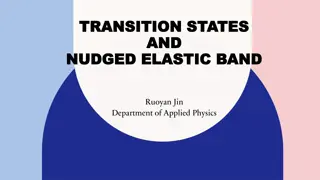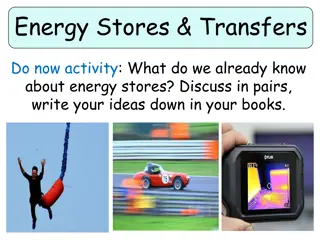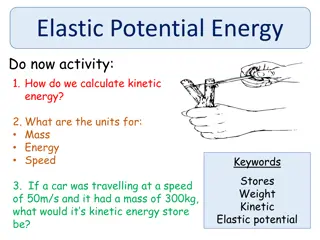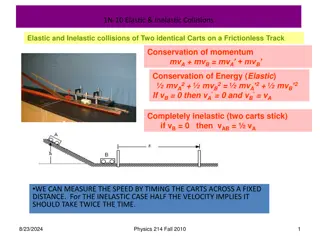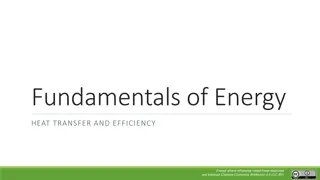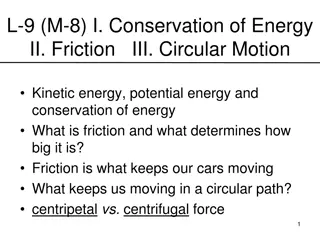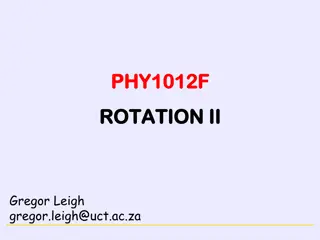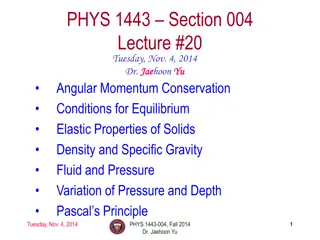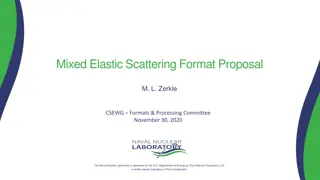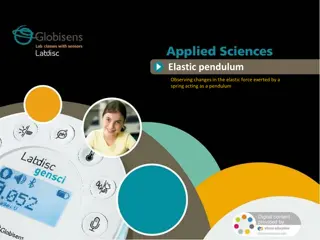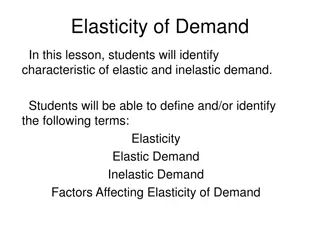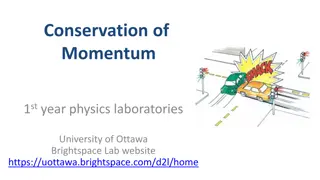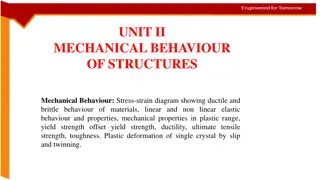Understanding Elastic Potential Energy and Energy Conservation Principles
Elastic potential energy is stored in elastic bodies like springs and is vital in understanding energy conservation principles. This energy can be calculated using the work done by an ideal spring on a block. By applying elastic potential energy concepts, one can analyze scenarios where a spring system converts potential energy to kinetic energy. This exploration highlights the interconnected relationship between potential energy, work done, and force in systems governed by elastic properties.
Download Presentation

Please find below an Image/Link to download the presentation.
The content on the website is provided AS IS for your information and personal use only. It may not be sold, licensed, or shared on other websites without obtaining consent from the author. Download presentation by click this link. If you encounter any issues during the download, it is possible that the publisher has removed the file from their server.
E N D
Presentation Transcript
POTENTIAL ENERGY AND POTENTIAL ENERGY AND ENERGY CONSERVATION PART II ENERGY CONSERVATION PART II
Elastic potential energy Figures below show how a spring does work on a block as it is stretched and compressed.
Elastic potential energy, continued Let s calculate the work done by an ideal spring on a block as the spring stretches from ?? to ??: ??= ?? Now let s compare this equation to the definition of potential energy function: ????= ?? ?? Conclusion: not only spring force is a conservative force, but also we can associate elastic potential energy with it: ?????? = ?? ??( ??)?? =1 1 2??? 2 2 2??? ???=1 2??2
Elastic potential energy, details A body is elastic if it returns to its original shape after being deformed. Elastic potential energy is the energy stored in an elastic body, such as a spring. Figure at the right shows a graph of the elastic potential energy for an ideal spring. Note that the elastic potential energy is always positive. Also note that the elastic potential energy is set to zero at the equilibrium position of the spring. SI units are J (joules).
Applying elastic potential energy A glider with a mass of 0.200 kg sits on a frictionless horizontal air track, connected to a spring with a spring constant of 5.00 N/m. You pull on the glider stretching the spring by 0.100 m and then release it with no initial velocity. The glider begins to move back toward the equilibrium position (x = 0). What is its velocity when x = 0.080 m? ??= ??+ ???,?= 0 +1 2 2??? ??= ??+ ???,?=1 2+1 2 2??? 2??? ??= ?? 0 +1 2=1 2+1 2 2??? 2??? 2 ??? 2??? 2 2= ??? ??? 2)/? 2= (??? 2 ??? ?? 2 ??? 2)/? = 0.30 ?/? ??= (???
Applying elastic potential energy, continued Bar graphs representing the total energy (E), potential energy (U), and kinetic energy (K) of the glider-spring system in different positions. a. The total energy of the system equals the potential energy and the kinetic energy is zero, which is found at the point of the maximum stretch/compression od the spring. b. The glider is midway between the spring s maximum stretch and equilibrium points, so the kinetic energy plus potential energy bar graphs equal the total energy. c. The glider is at the equilibrium point of the spring, so the kinetic energy bar graph is the highest and equal to the total energy of the system.
Note on the application of elastic potential energy When a situation involves both gravitational and elastic forces, the total potential energy is the sum of the gravitational potential energy and the elastic potential energy: U = Ug + Uel. A bungee jumper transforms gravitational potential energy at the start of the jump into elastic potential energy at the bottom of the jump.
Nonconservative forces and the conservation of energy principle Work done by a nonconservative force cannot be described with the potential energy function. Applying the work-kinetic theorem we can conclude that the nonconservative forces do NOT conserve the total mechanical energy of the system E: ????= ?? ?? ????+ ???= ?? ?? ?? ??+???= ?? ?? ???= (??+??) (??+??)= ?? ??
Work done by nonconservative force and internal energy Work done by nonconservative force can be described in terms of internal energy energy associated with change in the state of matter. Temperature is the measure of the internal energy of a body as the temperature increases so does the internal energy. Work done by nonconservative forces equals to the change in the internal energy of a body: ???= ???? This leads to the law of conservation of energy for an isolated system: ? + ? + ????= 0 Note that the law of conservation of energy does not include work it allows us to think purely in terms of energy



